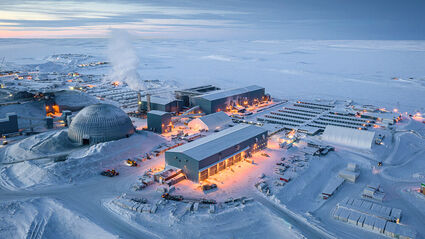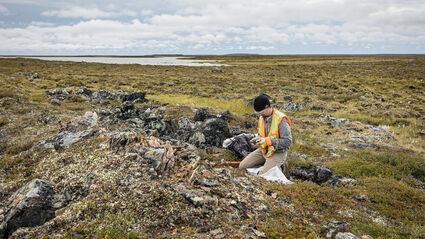Agnico pursues key goals in 2021
Expansion, exploration, emissions top miner's Arctic agenda Mining Explorers 2021 - January 27, 2022
Last updated 1/26/2022 at 4:14pm

Agnico Eagle Mines Ltd.
The Meadowbank mill processes ore shipped from Amaruq, a satellite deposit about 50 kilometers to the northwest.
For Agnico Eagle Mines Ltd., 2021 proved to be a transformative year at its operations in Nunavut.
The gold miner acquired a third mine in the Far North Canadian territory, completed extensive exploration programs at its mine properties in Nunavut, and edged closer to its goal of zero carbon emissions from its operations by 2050.
Agnico also entered a proposed merger-of-equals agreement with Kirkland Lake Gold, a combination that would create the third-largest gold miner in the world behind Newmont and Barrick Gold with a combined market capitalization of US$23.7 billion, according to a 2021 Mining.com ranking of mining companies.
Hope Bay acquisition
In February, the company acquired TMAC Resources Inc. and its Hope Bay gold mine and expansive land package in northwestern Nunavut in a transaction valued at roughly C$286.6 million.
With more than 1 million meters of drilling completed before the sale (3,270 meters in 2020), Hope Bay hosts nearly 17 million metric tons of proven and probable mineral resources averaging 6.5 grams per metric ton (3.55 million ounces) gold. A preliminary feasibility study completed in 2020 projects a mine‑life of 15 years and a new processing plant under construction at Madrid to be operational by 2024.
Extensive exploration
The gold miner also mounted major exploration programs in 2021 at its three main mine assets in Nunavut. By early November, Agnico had invested more than US$33 million in exploring the Meliadine Mine, Meadowbank Complex, and the Hope Bay mine. The outlay represented roughly 20% of the company's 2021 exploration budget of US$163 million.
"The 2021 exploration program is the most ambitious in Agnico Eagle's 64-year history, as we investigate the full potential of existing operations and key projects in the company's pipeline," CEO Sean Boyd said in a statement.
The gold miner also launched initiatives in Nunavut to reduce greenhouse gas emissions at its operations. In 2020, the company's GHG emissions totaled 578,156 metric tons of carbon dioxide equivalent, an 11% increase over comparable emissions in 2019, and the emissions intensity (metric tons of CO2eq per ounce of gold processed) increased by 7% to 0.40 in 2020.
Agnico said both increases relate primarily to the ramp-up of its operations in Nunavut.
"While there is still work to do, (Agnico) believes it has the lowest GHG emissions intensity in its peer group, achieved by sourcing 52% of its electricity needs from renewable sources," the miner noted in a recent report.
Increased emissions in 2019 and 2020 resulted from expansion of the Meadowbank Complex and the start-up of the Meliadine mine, where the only available source of power is diesel generators.
The miner said it sees potential to materially reduce its GHG emissions for the mining operations and for the entire Kivalliq region of Nunavut where the mines are located by building a power (and fiber optic) line sourcing green renewable energy from Manitoba.
Agnico is actively working with local Inuit associations and the Canadian and Nunavut governments to advance construction of a power/fiber line in the territory.
Wind power at Hope Bay
The company is also pursuing energy alternatives, including wind generation at the Hope Bay mine.
In July, Agnico signed an agreement with a new consortium, made up of Quebec-based Tugliq Energy Co. and Hiqiniq Energy Corp., a subsidiary of Kitikmeot Corp., the Inuit association for Nunavut's northwestern region.
Under the new memorandum of understanding, Tugliq and Hiqiniq plan to build and operate a wind turbine project at the Hope Bay site and sell power to Agnico for the mining operation.
"Wind energy is quickly evolving, and these new wind turbine models have proven to work well in Arctic conditions. Globally, we are at a critical juncture in the climate crisis, and we know that the status quo cannot be maintained," the miner said in a statement.
Tugliq Energy is experienced in harnessing wind energy at Arctic mine sites. The company operates two three-megawatt turbines in Quebec at Glencore's Raglan mine in Nunavik. Since 2018, the two turbines have helped displace 4.2 million liters of diesel used at that mine site, Tugliq said.
More gold at Hope Bay
At US$16.2 million, Agnico mounted the largest drill program in Nunavut in 2021 at Hope Bay.
Agnico said it sees tremendous exploration potential across the 181,677-hectare (448,933 acres) remote Arctic property, which encompasses two 80-kilometer- (50 miles) long greenstone belts (Hope Bay and Elu).
The company spent US$5.5 million to complete about 29,800 meters of delineation drilling at Doris, the area currently mined at Hope Bay, and another US$10.7 million on roughly 39,800 meters of exploration drilling around Doris, Madrid, and regional targets.
By early November, more than 71,500 meters of drilling had been completed at Doris and the Madrid deposit, topping 69,600 meters planned for 2021.
Numerous high-grade intersections cut in drilling at Doris include 3.3 meters averaging 21.4 g/t gold in hole DCN21-50284 (West Valley Zone); 12.6 meters averaging 12.9 g/t gold in hole DCN21-50418 (DSN Zone); and 3.2 meters averaging 32 g/t gold in hole DBE21-50469 (BTD Extension Zone).
An exploration drift developed in November to the West Valley Zone will target a gap between the dike and the previously defined West Valley mineral resources to the north.
Agnico also said there is good potential to extend the deposit along strike to the north and to add to the mineral resources at Doris beneath a diabase dike with continued drilling on the BTD Extension, BTD Connector/West Valley, and BTD Central zones.
Agnico also drilled the shallow portion of the Madrid deposit to test the area around the ramp portal in the Naartok West Zone to delineate the upper reaches of the deposit while investigating potential parallel structures in the hanging wall and footwall of the main ore zone.
The drilling confirmed grade and thickness continuity of the Naartok West Main Zone, which remains open along strike and at depth. Exploration in the western Naartok West area also resulted in the discovery of a new zone of north-trending stacked splays.
Drilling in 2021 also confirmed an extension of the Naartok East Zone further north with six meters of 11 g/t gold cut in hole HBM21-024 and 13.7 meters of 8 g/t gold in hole HBM21-010. The Naartok East Zone remains open to the north along strike and at depth.
Agnico said there is also excellent exploration potential at the Boston deposit and on a regional scale within the Hope Bay and Elu greenstone belts, where more than 90 regional exploration targets have been defined by surface mapping and sampling, and geophysical and geochemical surveys.
Upgrading, expanding Meliadine
Roughly US$9.8 million of Agnico's 2021 exploration budget funded work at Meliadine, a gold mine about 25 kilometers (16 miles) north of the community of Rankin Inlet.
Meliadine hosts 21.3 million metric tons of proven and probable reserves averaging 5.89 g/t (4 million ounces gold) mostly at underground depth, along with 18.8 million metric tons of measured and indicated resources averaging 3.53 g/t (2.1 million oz gold), and 12.3 million metric tons of inferred resource averaging 5.82 g/t (2.3 million oz gold).
The reserves and resources are in seven deposits, including six in the current mine plan. Tiriganiaq is the largest, with a strike length of about 3,000 meters at surface and a known depth of 812 meters.
Some US$8.3 million of the 2021 exploration budget for Meliadine funded 44,000 meters of capitalized drilling focused on upgrading resources within Tiriganiaq, Normeg, and Wesmeg, as well as exploration drilling near the Tiriganiaq, Wesmeg, Pump, F-Zone, and Wolf deposits.
The remaining US$1.5 million financed about 7,000 meters of regional exploration drilling across the 98,222-hectare (242,712 acres) Meliadine property, including an 80-kilometer (50 miles) greenstone belt in Nunavut's Kivalliq District.
Agnico says conversion and exploration drilling in 2021 confirmed and expanded high-grade gold mineralization at Tiriganiaq, Wesmeg, and Normeg.
Regional exploration, meanwhile, continued to drill test targets around the Discovery deposit, including the Itiqlak-Aquarius target located 15 kilometers (nine miles) southeast of the mine. One hole drilled early in 2021 cut 3.5 meters averaging 21.7 g/t gold in the North Limb of a folded banded iron formation of Itiqlak-Aquarius.
Discovery is believed to have the potential to become a satellite deposit for Meliadine.
At and around Amaruq
Agnico spent another US$7 million for 34,900 meters of resource upgrade and exploration drilling at the Meadowbank Complex about 290 kilometers (180 miles) northwest of Meliadine.
The property includes the Meadowbank mine, closed in 2019, and Amaruq, a satellite deposit about 50 kilometers (31 miles) to the northwest that began delivering ore to the Meadowbank mill in 2019.
The 118,862-hectare (293,714 acres) Amaruq property hosts 19.9 million metric tons of open pit proven and probable mineral reserves averaging 3.64 g/t (2.3 million oz) gold; 3.3 million metric tons of underground probable mineral reserves averaging 5.29 g/t (564,000 oz) gold; along with substantial open pit and underground indicated and inferred mineral resources.
Most of 2021 drilling was carried out at Amaruq's Whale Tail gold deposit, VR and Mammoth zones, and several other gold exploration targets. The drilling focused on the area between the Whale Tail and IVR underground mineral resources where the explorer cut 2.6 meters averaging 26.6 g/t gold in hole AMQ21-2565 and 5.4 meters averaging 3.7 g/t gold in AMQ21-2608.
The explorer plans a follow-up program in this area in 2022 to increase confidence in the continuity of the underground gold mineralization between Whale Tail and IVR, as well as to extend any inferred mineral resources developed during this year's program.
Toronto-based Agnico also drilled 12 exploration holes during the first nine months of 2021 at Mammoth, a zone about 600 meters west of the Whale Tail pit, to test for the western extension of underground mineral resources.
Drilling highlights at Mammoth include 36.4 meters averaging 4.4 g/t gold in hole AMQ21-2603, which targeted the western extension of the zone at depth, and 4.7 meters averaging 5.1 g/t gold in a newly discovered area of mineralization about 40 meters north of the Mammoth zone. Follow-up drilling continued at Mammoth late in the year.
Over the first nine months of 2021, Agnico also drilled 54 holes at regional exploration targets around Meadowbank and Amaruq. This included nine holes drilled at Greyhound, a property about 50 kilometers (31 miles) south of Meadowbank that Agnico is exploring under a joint venture with Gold79 Mines Ltd. The drilling targeted the Dingo, Aura, and Outstanding Lake prospects, where polymetallic volcanogenic massive sulfide mineralization has been identified in boulders at the surface.

















Reader Comments(0)